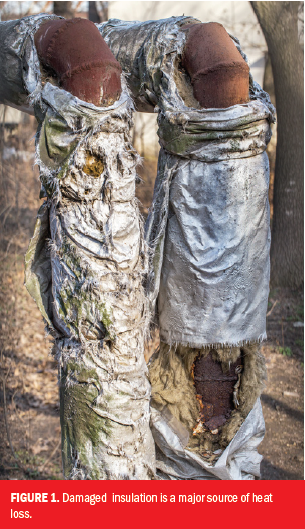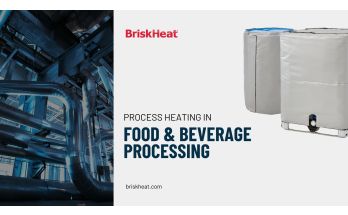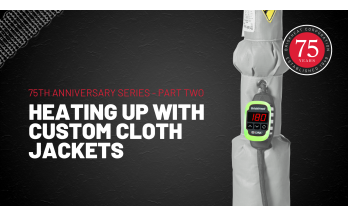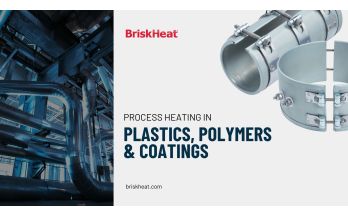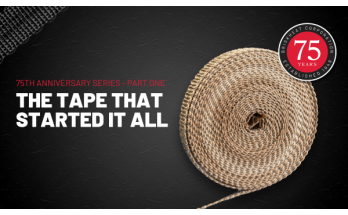Process heating can be a critical factor in manufacturing and can contribute to the overall cost of operation. Insulation is an important factor in minimizing heat loss. Often, this is not considered during the design phase. After construction, adding, or increasing insulation thickness may be difficult. Using a less efficient heating system is like throwing energy dollars out the window. Insufficient insulation can jeopardize worker safety as well as product quality. It can also lead to increased greenhouse gas emissions and damage to temperature sensitive equipment.
The key to energy efficient heating systems includes:
► Knowledge of your heating requirements
► Examining potential sources of heat loss
► Selection of insulating material
► Separate or integrated heating
► Proper installation techniques
Determining Heating Requirements
Process, Industrial or Application Engineers will typically outline a flow diagram to describe the process requirements. Equipment specific to the manufacturing process is planned along with any material handling requirements to move material from one area to another. When the process requires heating material, calculations are made to consider:
► the lowest temperature for material introduced
► the desired temperature increase during that stage
► how quickly the temperature must rise
► environmental conditions around the equipment.
All this factors into determining the amount and location of required heating.
Sources of Heat Loss
Any time heat is transferred to a mass other than as intended, it is considered heat loss. Heat loss can result from:
► Conduction - the transfer of heat from a hot mass to a mass that is colder. If a pipe is hot and heat transfers to a pipe stand or bracket, it is lost rather than all heat transferring to the product within the pipe.
► Convection - the result of heat from a hot object moving to a cooler area like hot air leaking to atmosphere from an opening in a furnace wall.
► Radiation - the transfer of electromagnetic energy through space.
► Evaporation - additional energy is required to evaporate condensate during cooling, or as part of a chemical reaction.
A major source of heat loss is poor insulating practice. This can be insufficient thickness, but more often, is the result of damaged insulation. Important items to look for during insulation inspection are:
► Tears in the outer covering
► Damaged or missing lagging
► Loose insulation on the floor
► Discoloration of insulation or outer coverings
► Exposed surfaces
► Areas of increased temperature identified by thermal images
In some cases, further investigation (e.g. remove coverings or the insulation) is needed to identify the underlying problem.
Insulating Material Selection
Material selection is a critical component to energy efficiency. Different materials and thicknesses impact efficiency by reducing heat loss. Application temperature, installation, environment, and durability are vital considerations. All these materials can be applied directly over piping or flow control components and some can be used in formed insulators with covering material. Fiberglass, Aerogel, polyimide fiber, and silicone sponge can be used in all-in-one heated insulating jackets.
Heating jackets are insulators with built-in heating wire which may include covers of different materials. Covers are used to prevent UV degradation, unintentional damage, moisture permeation or environmental wear of the insulation. If the insulation will be removed and reinstalled in the same location, chosen insulation should be durable and easy to handle.
Fiberglass mat can be cut and wrapped around pipe, components, or vessels. Fiberglass has a low thermal conductivity and is suitable for high temperature applications but requires an outer layer.
A fiberglass insulating jacket is made by sandwiching insulation between two pieces of material selected specifically for the application. Outdoor applications require moisture resistant fabrics to prevent water or other liquids from saturating the insulation and decreasing performance (reduced R-Value). The jacket may also protect the insulation from abrasion, or unintentional tearing.
Calcium Silicate (Cal-Sil) is made from limestone and diatomaceous earth. The material is molded into required shapes for pipes, fittings, components, or flat sheets. It has high compressive strength, is abuse resistant, and some variations are water resistant. It has a low thermal conductivity value; however, installation may be time-consuming.
Mineral Wool is made by spinning the fibers of molten minerals including slag and ceramics. It can be shaped and stiffened by adding binding materials. Thermal conductivity is lower than fiberglass and density is higher. The higher density means it is much less likely to fold or slump. fittings, components, or flat sheets. It has high compressive strength, is abuse resistant, and some variations are water resistant. It has a low thermal conductivity value; however, installation may be time-consuming.
Silica Aerogel works well in many industrial applications because it has very low thermal conductivity and a rofile up to 75% thinner than competing materials. The material is moderately durable and, can be removed and reused. Important properties include hydrophobicity, meaning resistant to moisture. Moisture can cause corrosion on surfaces under the insulation which may not be noticed under casual inspection.
Polyimide Fiber is a light weight, reinforced insulating blanket with low thermal conductivity and more durable than fiberglass. It is resistant to acids, hydrocarbons, and most solvents. It is drapable, for easy installation and can be used as insulation in component jackets.
Silicone sponge can be manufactured in different ways that impact the overall performance; however, application temperatures are lower, and it often lacks resistance to wear. A silicone jacket may be placed on the outside of the sponge to increase durability. The cost of silicone sponge is often higher than fiberglass. Elastomeric foam is lower cost compared to silicone sponge; however, has a lower temperature rating, 250°F (120°C). Tubular foam is flexible, even at colder temperatures, and used in industrial and residential applications. This material is well suited for freeze protection, insulation of hot water pipes, and condensation protection.
Cloth heating jackets combine form-fitting insulation and the heat required for a process requiring heat. These can be custom engineered for piping, flow-control components and vessels. Things to consider are:
► Can a heating tape, cable or blanket be placed around the components to maintain good surface contact and uniformity?
► Will insulation need to be removed for maintenance and how time consuming is the process?
Valves, pumps, flow meters, flanges, strainers and other flow components pose special challenges. Their complex shapes and variable masses make it especially important to properly heat and insulate as much surface area as possible. If a 4” gate valve has hot gas flowing through it, the valve will quickly lose heat due to the mass of the valve body, which acts like a heat sink. The exposed surfaces of the valve present more area for heat dissipation, and direct contact with a heater is more difficult. A custom cloth heating jacket (Figure 6) caninclude the heating wire, insulation, sensor and controller for maximum efficiency.
Vacuum chambers can be another challenge for heating and reducing heat loss. The vacuum chamber jacket (Figure 7) requires both heat and insulation. Applying heat with individual tapes and maintaining uniformity would be difficult. Sewing heaters into the jacket greatly increases temperature uniformity, eliminates potential gaps and greatly decreases installation time. Figure 8 shows how heaters can be incorporated to achieve better performance.
Insulation Thickness
After determining which types of material may be suitable, it is necessary to determine insulation thickness based on the application. The thicker the material layer, the less the heat loss. Insulations are available in different densities which will impact the thermal conductivity. To determine the thickness, consider required surface temperature. If the temperature exceeds 140°F (60°C), it may be necessary to add protective guards to maintain a safe working environment. The cost of guards versus the cost of thicker insulation should be weighed, and physical barriers that may prevent access for maintenance should be considered.
Proper Installation Techniques
Proper heater and insulator installation is critical to not only energy efficiency, but quality of the material flowing through the system. Regardless if it is fuel gas, heating oil, steam, or honey, the process has special requirements for the exiting fluids. The proper fit and positioning is critical to meeting this requirement.
Self-regulating cable, flexible heating tapes, heat-trace cable, and Mineral Insulated (MI) cable are potential options for component heating. Select a heater with required wattage and coverage area based on heat losses for insulation to be used and follow the manufacturer’s installation instruction. These can be cost effective “off the shelf” solutions for heating simple shapes where they are able to provide good surface coverage as required to heat and maintain temperature.
Insulation should fit securely, and not allow gaps where heat may escape. It should not be the means to secure the heater in place. Cloth jackets have various fastener types and are designed for easy removal and reuse. The jackets are engineered to match the component’s dimensions. A tight and secure fit ensures the temperature sensor and heating wires are in direct contact with the component. All pipe, fittings and components should be insulated, leaving no gaps between insulators.
Conclusion
Heat loss can be a major concern for all companies, not just manufacturers; however, heat loss can be reduced by careful system design and inspection. Utilizing the tips presented here will help reduce heat loss, increasing system efficiency and saving money. Insulation selection and proper installation are key factors in system design and require careful consideration. A qualified heating company can be consulted for application support.

